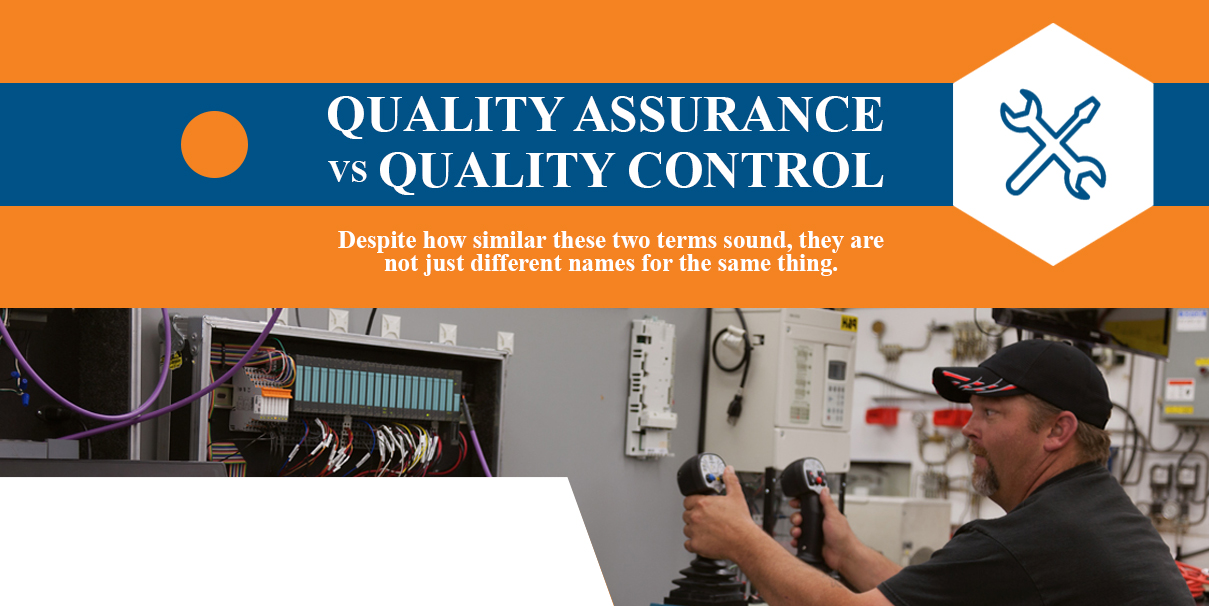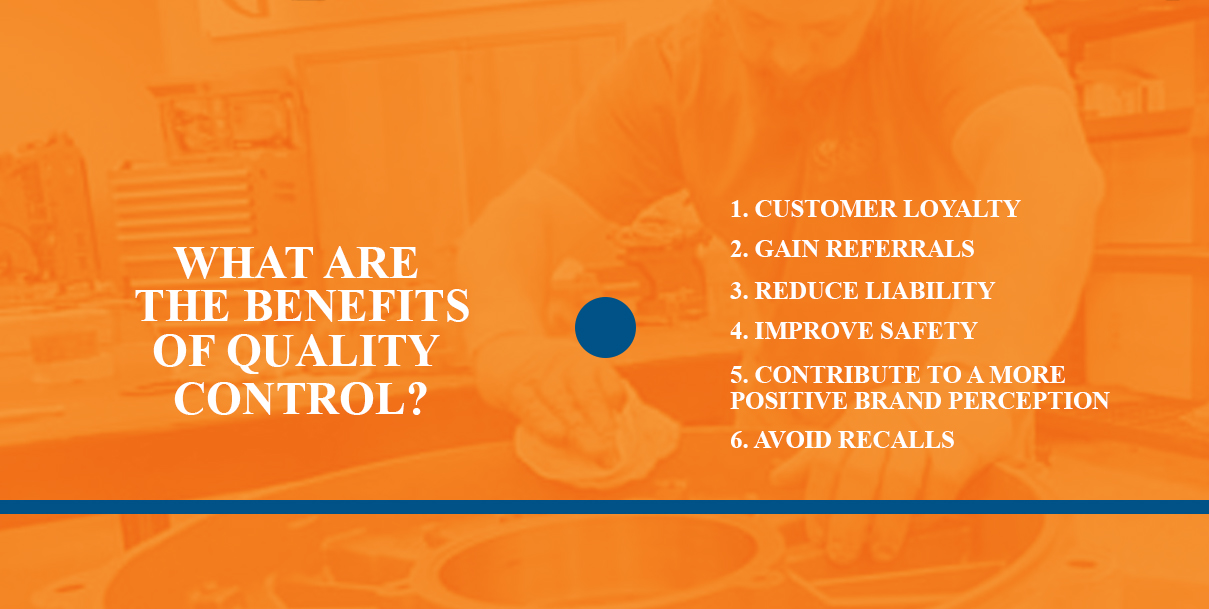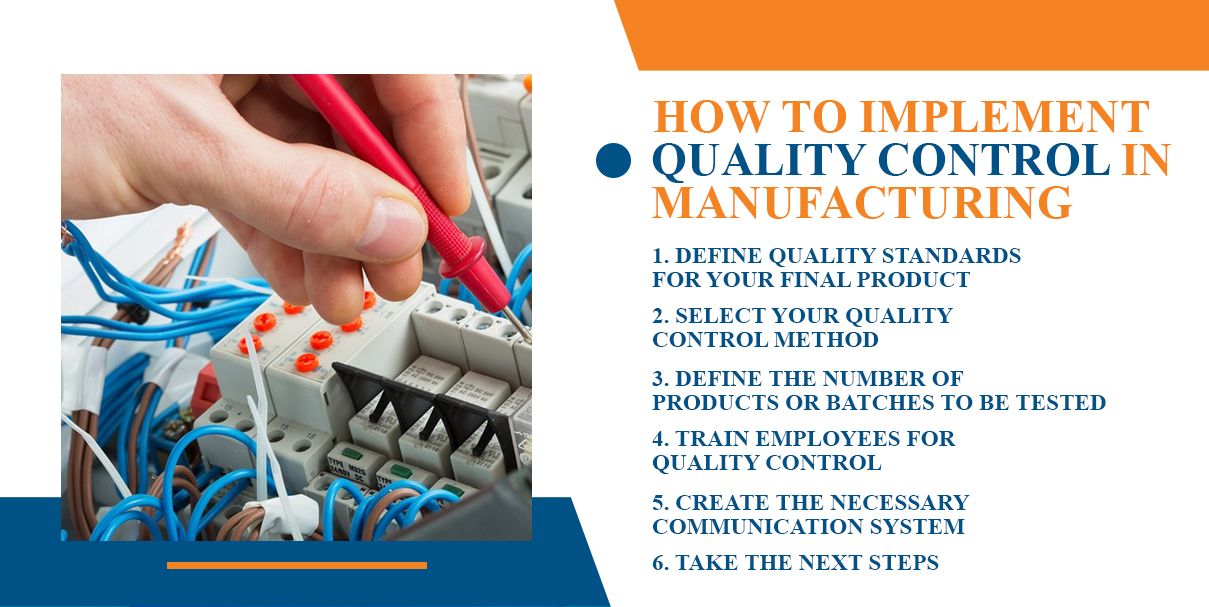Quality Control in Manufacturing

If you’re in the manufacturing industry, you know it’s important to deliver high-quality products. You also know the importance of sticking to a deadline and reaching your goals. Sometimes, it can be difficult to make these two goals align. There will always be cases where it seems like you have to choose between meeting your goals and producing the best-quality product possible.
At the intersection of efficiency, safety and quality lies a concept known as quality control. You’ve no doubt heard this term, and it’s likely that you even practice it in your own workplace. To ensure that everyone is on an equal footing, however, a definition is in order. Quality control in manufacturing is the process of ensuring that every product you manufacture is up to a pre-defined quality standard. It means that anything falling below this standard will never make its way out into the world to be sold.
There are lots of different means of doing this. You might install different checkpoints along the production line, as well as a final inspection. You might implement more rigorous employee training programs. You might take greater care with the materials being used in the manufacturing process. You might begin performing random checks and inspections. There are numerous ways to implement quality control measures and you might choose a few specific methods or all of them at once.
This guide covers why quality control is important, how it can work to your benefit and common problems that might arise as you implement processes — so you can begin instituting these policies and putting these practices to work in your own manufacturing company.
What Are the Benefits of Quality Control?
Quality is important in the manufacturing process for many reasons. Here are just a few of the reasons it’s beneficial to make quality products:
1. Customer Loyalty
It should come as no surprise that customers enjoy, appreciate and even demand high-quality products. If your company is not producing items that suit customer standards, they will not hesitate to move to a different company that will.
However, the reverse of this is also true. If your company consistently creates premium-quality products, customers will stick around. They’ll develop a sense of loyalty to you and be reluctant to buy other companies’ products. To achieve this kind of loyalty, however, you first need to manufacture a great product and that starts with quality control.
2. Gain Referrals
One of the primary benefits of customer loyalty isn’t just that you enjoy the business of one repeat customer. It’s that this one customer will almost certainly go out and tell their friends what a good experience they had with your products, thus bringing in more customers by way of referral. In an ideal scenario, then, your customer base should grow exponentially with every new customer referred to you. Again, however, it’s important to remember that this level of success is dependent on reliable quality control.
3. Reduce Liability
A lawsuit is one of a manufacturing company’s worst nightmares. There are few things worse than one of your products working incorrectly and injuring someone, resulting in a lawsuit where your company faces blame for producing a faulty product.
Quality control helps reduce the amount of liability your company might face in these situations. If you can prove your company is taking all necessary and possible steps to ensure the quality and safety of every product, you significantly reduce your risk.
4. Improve Safety
Of course, the only goal isn’t to reduce your liability in the event of an accident. For any responsible manufacturer, the bigger goal is to limit the possibility of these accidents in the first place. Quality control can help make that happen. The more checks you have in place to catch mistakes before they make it out of the manufacturing room, the more you’ll improve the safety of everyone concerned.
5. Contribute to a More Positive Brand Perception
Every brand, if it gains enough public recognition, will begin to develop a reputation and connotations. Those can be either positive or negative, but either way, they’ll grow and become entrenched in people’s minds. That means it’s up to you to do everything possible to make sure your company’s reputation is a good one. You want to be known as a company that cares about their workers’ and customers’ safety. You want people to perceive your brand as one that only delivers the best. Quality control is where that starts.
6. Avoid Recalls
Recalling a product that’s discovered to be defective or problematic is not cheap. It’s also an enormous hassle. While no one can accurately prevent these accidents 100 percent of the time, quality control will go a long way towards minimizing these events and saving your company a lot of trouble.

Quality Assurance vs. Quality Control
You may hear “quality assurance” and “quality control” used interchangeably. However, these are two different concepts. Now that we have a basic understanding of quality control, let’s cover quality assurance.
Despite how similar these two terms sound, they are not just different names for the same thing. They’re actually two distinct concepts, although they are related. At the core, quality control (QC) is product-oriented while quality assurance (QA) is process-oriented.
In other words, quality assurance is all about dedicating resources to making sure that you’re doing things the way they should be done. Quality control is all about testing the final product and making sure that doing things properly along the way leads to the results you want and expect.
With these definitions, we can see that if you’re having process issues in manufacturing, you’ll want to address it with your QA team. If you’re having product issues, you’ll want to address it with your QC team, although both teams may end up getting involved.
It’s important to realize that while these are two different concepts, they are also inextricably linked. Even though quality control is primarily focused on the final product, they’re also necessarily concerned with the process. After all, there is no product without a production process. If something is wrong with the product, they’ll let the QA team know that some problems should be addressed along the production line.
In this way, there is a fair amount of overlap between these two different ideas.
Common Process Issues in Manufacturing That Quality Control Can Help With
Because there is significant overlap between the ideas of quality control and quality assurance, it shouldn’t come as a surprise that QC teams are also often concerned with the manufacturing process, instead of solely being interested in the final product. In fact, quality control can play a large role in your process itself.
Just a few of the common problems in the production line that quality control can help with include:
- Incorrect Output: When market demands are constantly fluctuating, it can be difficult to adjust your output. As a result, you may end up producing too much or too little.
- Missing Information: When everything is moving quickly, it can be easy to find yourself with a distinct lack of real-time information about what’s going on in your own production line.
- Unbalanced Workload: If you’re not careful, you can easily find yourself in a situation where your production is unevenly spread out, with some workstations overflowing and others that are severely underused.
- Incorrect Manufacturing Speed: Is your manufacturing time too slow? Too fast? Quality control can help with this.
- Delays in Changing Production: Large delays can result when you have to change over one assembly line for another, putting a major snag in your operations.
- Problems Switching Assembly Lines: If you’re still adjusting to a new assembly line, you might easily be wasting time somewhere along the line and slowing down production.
- Problems With an Existing Assembly Line: Even if your assembly line is a familiar one, problems can still arise that result in delayed production. Quality control can help look into these problems and set you on the right path again.
- Faulty Final Product: A poor final product is clearly a problem and one that quality control can certainly help address.
How to Implement Quality Control in Manufacturing
We know quality control is important. We know it can benefit you in a multitude of ways and solve lots of problems along your production line. So now let’s talk in practical terms. You can implement quality control in your manufacturing operations by following this process:
-
Define Quality Standards for Your Final Product
It can be difficult to talk about quality control if you aren’t even sure what constitutes quality in the first place. That means you’ll want to start by setting some defined parameters for what quality is. By doing this, you’ll be better equipped to recognize when something falls outside of these boundaries and can, therefore, be considered low-quality.
To do this, ask yourself what your final product should look like, what it should achieve and how long it should last. Then think about what would constitute a failure in all of these aspects. Use your answers to create a clearly defined list, which becomes your quality standard.
-
Select Your Quality Control Method
There are so many different ways to perform quality control. Maybe you’ll do random checks. Maybe you’ll examine 20 final batches and analyze them for defects. Whatever method you choose, take some time to think about your production and the unique struggles you’re facing. Think about which method or methods would be the most effective at helping you combat these problems and then move forward in that direction.
-
Define the Number of Products or Batches to be Tested
Realistically, you will probably only be able to test so many products or batches. There will simply not be the time or resources necessary to test every single product that rolls off your production line. Instead, you’ll have to think carefully about how many products to test. To arrive at a final number, ask yourself how many batches you need to test to truly feel you have an accurate sample size.
Take your time, decide how many products you’ll be testing and then move forward to the next step of the process.
-
Train Employees for Quality Control
This is a crucial step in the process and one that cannot be overlooked. You’ll want to carefully select and train employees to be your company’s quality control agents. This means more than simply training them in generic quality control methods, although this is certainly part of it. It also means walking them through what you’ve already defined as your quality standards and making sure you’re on the same page when it comes to recognizing a product that misses these standards.
You want to create a QC team that you can absolutely rely on when it comes to testing your company’s products. This often means investing considerable time and resources into training them and educating them on your company’s standards and goals. If you’re willing to make this investment, it will pay off in the form of a team that performs excellent quality control work for you.
-
Create the Necessary Communication System
Once your team is in place and ready to begin their work, the last piece of the puzzle is your communication network. Your team needs a reliable means of reporting their findings. Whether that consists of weekly meetings, emails or something else altogether, this is crucial to establish up front. If your team is working, but the findings are never making their way to the appropriate people, then nothing can change despite the quality controls measures you’ve implemented.
Spend some time thinking about the best method of reporting these results and then get the system into place.
-
Take the Next Steps
Let’s assume that your quality control team has begun doing their work and has reported their findings to you. Let’s say you see the results and realize that there are a few problems with the final products. At this point, you’ll have a few decisions to make. You’ll want to ask yourself questions such as:
- Will we reject the defective products?
- What methods will we take to prevent future defective products?
- Will further testing be necessary to determine more conclusive results?
- Will production need to halt until the problems are resolved?
With many of these questions, the answers fall more into the territory of quality assurance, proving even more how these two concepts are related. By practicing responsible quality control, you’ll find that your quality assurance processes become much more useful and relevant. In this way, the two different practices complement one another and lead to a better process and final product.
Read More From Global Electronic Services
Looking to learn more about the manufacturing industry and ways you can streamline and improve your processes? Keep reading our blog for more great tips and information on manufacturing, technology, customer service and more. At Global Electronic Services, we repair and service all types of industrial electronics, motors, pneumatics and hydraulics. If you have any questions about our services, don’t hesitate to contact us and we’ll be happy to help you find the solution that works for your company.



